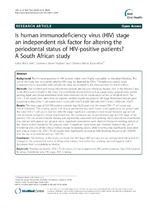| dc.contributor.author | John, Cathy N. | |
| dc.contributor.author | Stephen, Lawrence X.G.S. | |
| dc.contributor.author | Africa, Charlene W.J. | |
| dc.date.accessioned | 2014-01-09T08:03:49Z | |
| dc.date.available | 2014-01-09T08:03:49Z | |
| dc.date.issued | 2013 | |
| dc.identifier.citation | John, C.N., Stephen, L.X.G.S. & Africa, C.W.J. (2013). Is human Immunodeficiency virus (HIV) stage an independent risk factor for altering the periodontal status of HIV-positive patients? A South African study. BMC Oral Health, 13(69): 1-8 | en_US |
| dc.identifier.issn | 1472-6831 | |
| dc.identifier.uri | http://hdl.handle.net/10566/924 | |
| dc.description.abstract | Background: The immunosuppresion in HIV patients makes them highly susceptible to microbial infections. The
aim of the study was to establish whether HIV stage (as depicted by CD4+ T lymphocyte counts) could
independently be associated with periodontal status (as revealed by the measurement of clinical indices).
Methods: One hundred and twenty HIV-infected patients attending an infectious diseases clinic in the Western Cape,
South Africa were included in the study. The periodontal clinical indices such as plaque index, gingival index, pocket
probing depth and clinical attachment levels were measured on the mesial aspect of the six Ramfjord teeth. The
CD4 + T cell counts were taken from the patients’ medical records and patients’ HIV stage determined and grouped
according to their CD4+ T cell counts into A (<200 cells /mm3), B (200–500 cells /mm3) and C (>500 cells /mm3).
Results: The mean age of 120 HIV-positive patients was 33.25 years and the mean CD4 + T cell count was
293.43 cells/mm3. The probing depth and clinical attachment loss were found to be significantly associated with
the total CD4 + T cell counts but not with HIV stage. Significant correlations were found between age and all
clinical indices except for clinical attachment loss. No correlation was found between age and HIV stage of the
patients. The use of antiretroviral therapy was significantly associated with probing depth and clinical attachment
loss, but not with plaque nor gingival index. Significant associations were observed between smoking and all of
the clinical indices except for the gingival index. A significant association was observed between the use of
interdental aids and all the clinical indices except for probing depth, while brushing was significantly associated
with plaque index only. CD4 + T cell counts were significantly associated with brushing frequency (p = 0.0190)
and the use of interdental aids (p = 0.0170).
Conclusion: The findings of this study conclude that HIV stage, ART and age are not independent risk factors for
changes in the periodontal status of HIV-positive subjects but rather that smoking and oral hygiene habits
determine their susceptibility to disease. | en_US |
| dc.description.sponsorship | National Research Foundation | en_US |
| dc.language.iso | en | en_US |
| dc.publisher | BioMed Central | en_US |
| dc.rights | © 2013 John et al.; licensee BioMed Central Ltd. This is an Open Access article distributed under the terms of the Creative Commons Attribution License (http://creativecommons.org/licenses/by/3.0), which permits unrestricted use, distribution, and reproduction in any medium, provided the original work is properly cited. | |
| dc.source.uri | http://dx.doi.org/10.1186/1472-6831-13-69 | |
| dc.subject | Periodontal disease | en_US |
| dc.subject | CD4 + T cell counts | en_US |
| dc.subject | Immunosuppression | en_US |
| dc.subject | HIV-positive patients | en_US |
| dc.subject | Age | en_US |
| dc.subject | Oral hygiene | en_US |
| dc.subject | Brushing | en_US |
| dc.subject | Interdental aids | en_US |
| dc.subject | HIV stage | en_US |
| dc.subject | ART | en_US |
| dc.subject | Smoking | en_US |
| dc.title | Is human Immunodeficiency Virus (HIV) stage an independent risk factor for altering the periodontal status of HIV-positive patients? A South African study | en_US |
| dc.type | Article | en_US |
| dc.privacy.showsubmitter | false | |
| dc.status.ispeerreviewed | true | |

